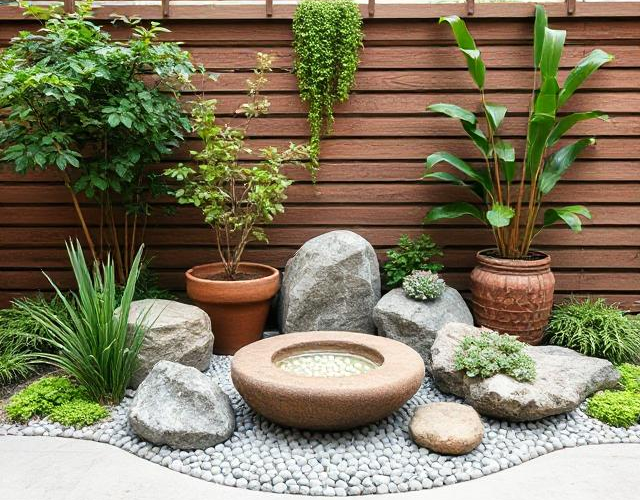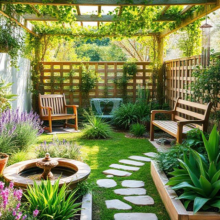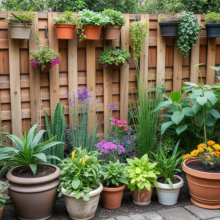A Complete Guide to Creating Zen Garden for Small Spaces

 Introduction
Introduction
In today’s fast-paced world, finding tranquility within the comfort of your home is essential. A Zen garden offers a sanctuary for relaxation and mindfulness, embodying the principles of simplicity, balance, and harmony. Even if you have limited outdoor space, you can create a stunning and functional Zen retreat that fosters peace and contemplation. This guide explores Zen garden ideas for small spaces, design principles, plant choices, and layout arrangements to help you craft a serene escape.
Principles of Zen Garden Design
Zen gardens, or “karesansui,” originate from Japan and are designed to emulate the natural landscape using rocks, gravel, sand, plants, and water elements. The fundamental principles include:
- Simplicity: Minimalist design with intentional placement of elements.
- Asymmetry: Avoiding perfect symmetry to reflect natural randomness.
- Balance: Harmonizing different components like rocks, water, and plants.
- Symbolism: Using elements to represent mountains, rivers, and islands.
Understanding these principles helps in designing a small yet impactful Zen garden that embodies peace and harmony.
Best Zen Garden Ideas for Small Spaces
1. Balcony or Patio Zen Garden
Transform your balcony or patio into a meditative space by incorporating:
- A small raked sand tray: Simulating water movement with fine sand and a miniature rake.
- Mini bonsai trees: Such as Japanese Black Pine (Pinus thunbergii) or Fukien Tea Bonsai (Carmona retusa).
- Pebble arrangements: White or black pebbles for contrast and depth.
- A compact stone lantern: Adding a traditional Japanese touch.
2. Rock and Gravel Zen Garden
If you have a small backyard or side yard, consider a rock garden layout:
- Central boulder feature: Position a weathered rock as the focal point.
- Gravel with raked patterns: Use fine white gravel to mimic rippling water.
- Stepping stones: Irregularly placed stones like Basalt or Slate for an organic feel.
- Minimalist plant selection: Add Dwarf Mondo Grass (Ophiopogon japonicus ‘Nana’) for ground cover.
3. Mini Water Feature Zen Garden
Even in a compact area, water can enhance tranquility:
- A tabletop water fountain: The soothing sound of flowing water creates a peaceful ambiance.
- Moss-covered stones: Incorporate Sheet Moss (Hypnum curvifolium) around the water feature.
- Small water lilies (Nymphaea tetragona): Ideal for tiny ponds or ceramic bowls.
4. Vertical Zen Garden
For limited spaces, consider a vertical garden approach:
- Hanging bamboo planters: Using Golden Bamboo (Phyllostachys aurea) for a calming green wall.
- Mounted rock displays: Attaching small rocks to a wooden or metal frame.
- Trailing plants: Such as Japanese Forest Grass (Hakonechloa macra) for cascading greenery.
5. Zen Garden with Seating Area
If you wish to meditate or relax in your Zen garden:
- A minimalist wooden bench: Crafted from natural wood or stone.
- Potted Japanese Maples (Acer palmatum): Small, vibrant trees that enhance seasonal beauty.
- Subtle lighting: Use solar-powered lanterns to illuminate the space at night.
Choosing the Right Materials and Plants
Recommended Plants for Small Zen Gardens
- Bonsai Trees: Japanese Maple, Juniper Bonsai, Fukien Tea Tree.
- Ground Covers: Moss, Dwarf Mondo Grass, Creeping Thyme.
- Flowering Plants: Camellia, Azalea, Irises.
- Ferns and Bamboo: Japanese Painted Fern, Dwarf Bamboo.
Materials for a Tranquil Zen Garden
- Gravel and Sand: White gravel for contrast, fine sand for raking patterns.
- Natural Stones: Basalt, Limestone, and Granite for rock formations.
- Wood Elements: Bamboo fencing, teak benches, wooden pathways.
- Water Features: Small stone basins, tabletop fountains, ceramic water bowls.
How to Maintain a Small Zen Garden
A Zen garden should be low-maintenance while retaining its pristine look. Follow these simple maintenance tips:
- Regularly rake the gravel or sand: To refresh the design and promote mindfulness.
- Trim plants and moss: Keep bonsai trees and ground covers well-maintained.
- Clean water features: Prevent algae buildup in small ponds or fountains.
- Remove debris: Sweep fallen leaves or dust to maintain cleanliness.
Real-World Examples and Case Studies
Example 1: Urban Apartment Zen Retreat
A city apartment balcony in Tokyo was transformed using a tabletop sand garden, a single bonsai tree, and a small rock formation to create a miniature representation of nature in just a few square feet.
Example 2: Backyard Zen Garden in a Small Courtyard
A small 10×10 ft courtyard in Los Angeles utilized a dry rock garden with a meditation corner, bamboo privacy screens, and a compact koi pond, providing a perfect meditation space despite space constraints.
Common Mistakes to Avoid
- Overcrowding: Avoid excessive decorations that compromise the simplicity.
- Using high-maintenance plants: Choose easy-to-care-for plants to ensure longevity.
- Lack of structure: Ensure elements are thoughtfully placed to maintain harmony.
- Ignoring scale: Select proportionate features to avoid overwhelming the space.
Final Thoughts
Creating a Zen garden in a small space is a rewarding way to bring peace and mindfulness into your home. Whether it’s a balcony, backyard, or patio, thoughtful design and material choices can transform even the tiniest area into a tranquil retreat.
Are you ready to build your own Zen garden? Start by sketching your design, gathering materials, and embracing the simplicity of nature. For more Zen garden inspiration and DIY kits, explore our recommended guides and resources.



